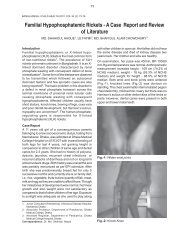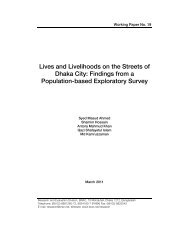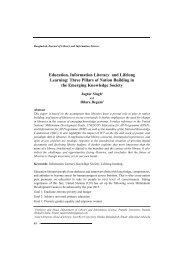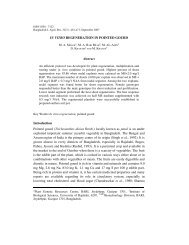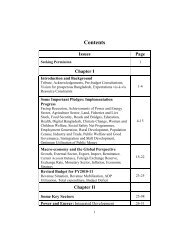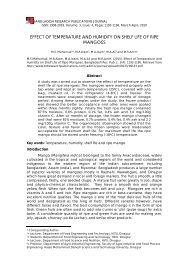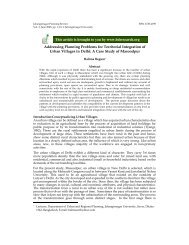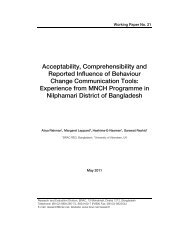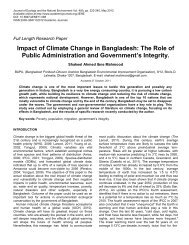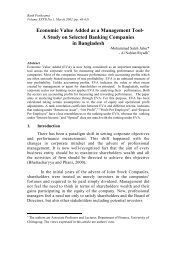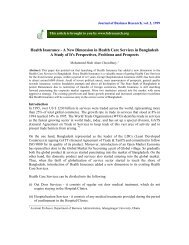Studies on Policy Option for Quality Seed Production and ... - NFPCSP
Studies on Policy Option for Quality Seed Production and ... - NFPCSP
Studies on Policy Option for Quality Seed Production and ... - NFPCSP
You also want an ePaper? Increase the reach of your titles
YUMPU automatically turns print PDFs into web optimized ePapers that Google loves.
`n<strong>on</strong>-lodging character’) from the year 2008 (the variety was correctly traced <strong>and</strong> re-c<strong>on</strong>firmed about itsprevalence in the particular area).In Rangpur, the time line of wheat seed producti<strong>on</strong> showed that during 1946-47 (just be<strong>for</strong>e Pakistanperiod) the farmers of Sullipara used to cultivate wheat in almost 10% of the total cropped area. It isevident from Table 4.2.7 that <strong>on</strong>ly two varieties were cultivated at that time <strong>and</strong> the yield was 1.5 t/ha.Area under wheat cultivati<strong>on</strong> increased from 10% to 40% during 1980-85. Side by side with theincrease in area, the yield also increased from 1.5 to 2.5 t/ha. The area under wheat cultivati<strong>on</strong>tremendously reduced during 2007-08. The reducti<strong>on</strong> was gradual <strong>and</strong> occurred over the years with theintroducti<strong>on</strong> of irrigati<strong>on</strong> <strong>and</strong> Boro rice cultivati<strong>on</strong>. It can be menti<strong>on</strong>ed that the wheat cultivati<strong>on</strong>shifted with other winter crops like maize, potato, Boro rice etc. although the number of wheat varietiesincreased from two to four maintaining almost similar yields.Table 4.2.7 Time line of wheat cultivati<strong>on</strong> in the study areasPeriod Variety Yield (t/ha)Bijoynagar (Rajshahi)1983 S<strong>on</strong>alika, Kanchan, Balaka 3.0-3.52008 Gourab, Satabdi, Kanchan 4.5-5.0Motiazapur (Dinajpur)1984-87 S<strong>on</strong>alika, Kanchan 2.5-3.02005-2007 Shatabdi, Prodip, Bijoy 4.5-5.02008 Swarna 3.5-4.0Sullipara (Rangpur)Be<strong>for</strong>e Pakistan M<strong>on</strong>i wheat 1.51980-85 S<strong>on</strong>alika, Kanchan 2.5-3.02007-08 Shatabdi, Sourav, S<strong>on</strong>alika, Kanchan 2.84.2.9 Adopti<strong>on</strong> of wheat varieties in the study areasMost of the wheat varieties cultivated at the study areas are developed by Bangladesh AgriculturalResearch Institute (BARI). Of these, Shatabdi, Prodip, Bijoy, Protiva, Gourov <strong>and</strong> S<strong>on</strong>alika weremostly cultivated in Rajshahi; Prodip, Shatabdi <strong>and</strong> Kanchan in Dinajpur; <strong>and</strong> Sourav, Shatabdi,S<strong>on</strong>alika, Protiva <strong>and</strong> Kanchan in Rangpur. But irrespective of farmers’ categories, the wheat cv.Shatabdi was the most adopted <strong>on</strong>e am<strong>on</strong>g the farmers of Rajshahi (62%) <strong>and</strong> Rangpur (27.7%) due toits higher yield <strong>and</strong> better per<strong>for</strong>mance under late sown c<strong>on</strong>diti<strong>on</strong>. In Dinajpur, 50.3% of the farmerscultivated the new variety Prodip (Table 4.2.8). The survey findings also reveal that the large farmershad given the maximum priority in obtaining the new wheat varieties like Prodip, Bijoy, Shatabdi etc.compared to small <strong>and</strong> medium farmers.The adopti<strong>on</strong> of wheat varieties mainly depends <strong>on</strong> the availability of seed, agro-climatic c<strong>on</strong>diti<strong>on</strong>s,grain quality, flour quality, farmers’ motivati<strong>on</strong>al activities (like training, field day etc.), <strong>and</strong> marketdem<strong>and</strong>. As these factors varied remarkably from site to site, the mode of disseminati<strong>on</strong> of the wheatvarieties also varied across sites.54



